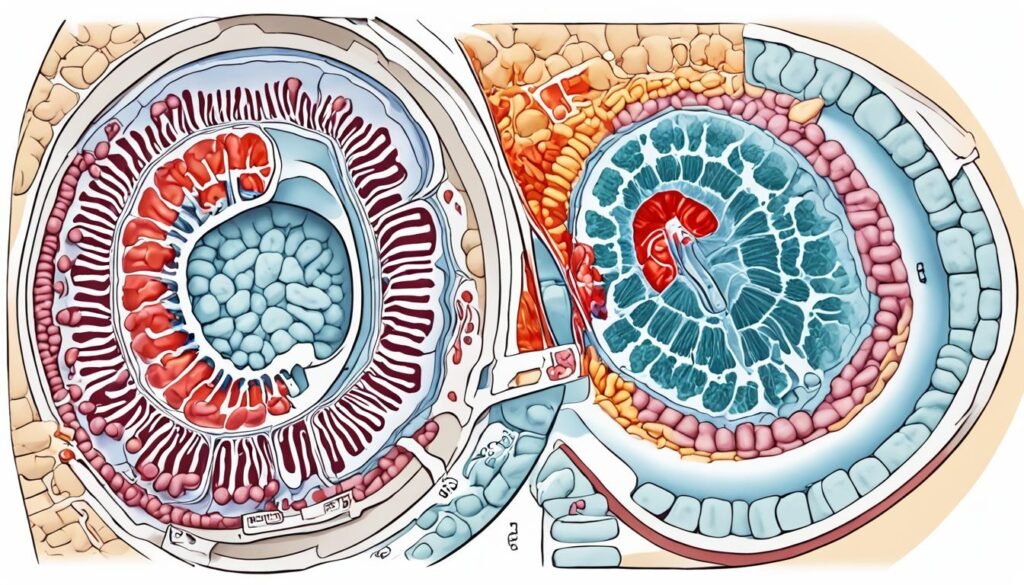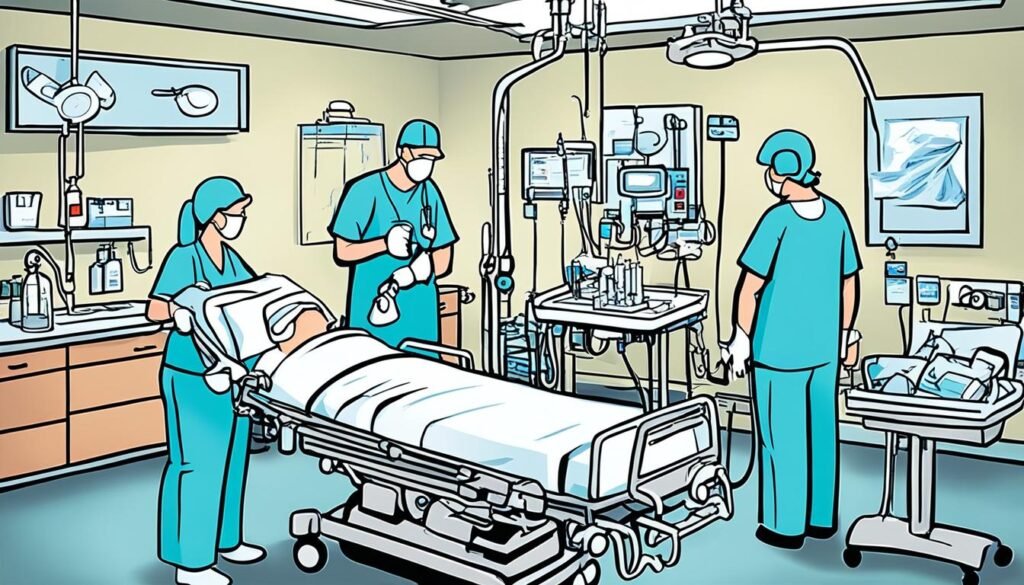|
Getting your Trinity Audio player ready...
|
Small bowel obstruction (SBO) is becoming a bigger issue in healthcare. Knowing how to treat it is crucial. It depends on understanding its causes, how it affects the body, and knowing how to diagnose it. There are many ways to classify this condition based on its specifics. Each case may need different treatment.
Table of Contents
ToggleObstruction can happen for different reasons. It might be due to a problem with the bowel’s wall or issues with a nerve. Or, it could be due to something blocking the bowel’s path. The blockage might be near the stomach (high SBO) or closer to the end of the bowel (low SBO). Or, it can be a type where the bowel is twisted, creating a loop, or a blockage with a clear exit.
Knowing what happens in the body when SBO occurs is important. It involves higher pressure inside the bowel, less blood flow, and changes in the body’s salts. Diagnosing SBO happens through symptoms, tests, and looking for signs of bowel stress.
SBO is a big issue, leading to many surgeries in the U.S. every year. Acute SBO can happen for many reasons. To treat it well, doctors need to understand these reasons and how they affect the body.
Understanding Small Bowel Obstruction
Definition and Classification
Bowel obstruction happens when there’s a blockage in our intestines. This blockage can be because of various reasons like problems with the gut’s wall or some nerve issues. It’s also classified as either functional or mechanical. Mechanical blockages might be at the start of the small intestine or farther down, and they can sometimes let a little bit through the blockage.
On the other hand, complicated obstruction is when blood flow to a part of the bowel is cut off. This can cause serious issues like tissue death and even a tear in the bowel.
Etiology and Causes
The reasons behind this kind of obstruction might include something physically blocking the intestine from the inside or outside. For example, one section of the bowel “telescoping” into another is called intussusception. Another scenario is when part of the gut twists around itself; this is called volvulus.
Sometimes, a gallstone from the gallbladder can move and cause a blockage in the gut; this is known as gallstone ileus. Finally, Littre’s hernia happens when a specific pouch in the gut gets trapped in a hernia outside the abdomen, causing a blockage.
Pathophysiologic Changes
In an acute small bowel obstruction, the body and bowel undergo serious changes. The area near the blockage can start to spasm, which can make things worse. When the blockage is total, the bowel can’t move properly, which causes of small bowel obstruction it to swell with fluid.
This swelling can cut off the blood returning from the bowel, which might make some parts of the bowel die. As the fluid becomes toxic, it can even cause life-threatening infections.
Diagnosis of Small Bowel Obstruction
Knowing the signs of Small Bowel Obstruction (SBO) early on is very important. This helps in starting the right treatment fast. It’s crucial to understand how patients show small bowel obstruction symptoms, what tests can be done, and look for signs of bowel complications.
Clinical Presentation
Symptoms of bowel blockages include pain, vomiting, no bowel movements, and a swollen belly. The pain usually starts sharp and then gets duller over time. Vomiting is common and the vomit might be green or look like food bits. Patients might not be able to go to the bathroom at all. In some cases, the blockage comes and goes, or the symptoms change quickly. This can hint at serious conditions.
Imaging Techniques
At first, a simple x-ray is used to diagnose acute SBO. Yet, CT scans with special contrast are more helpful. They can show exactly what’s going on inside. A ‘transition zone’ in the images often confirms the problem.
Identifying Bowel Compromise
Detecting serious issues like strangulation or tissue death is hard even for experts. They check for a rapid heart rate, belly pain, high white blood cell count, and fever. If imaging shows air or gas in unusual places, the patient might need surgery quickly.

Initial Management Approach
The main aims of treating small bowel obstruction (SBO) early are to lessen pain. It also works to fix body fluid levels, acid-base balance, and electrolytes. Getting enough fluids back into the body is vital. This is because SBO can quickly cause a loss of fluid and a disturbance in electrolytes.
Fluid Resuscitation
In SBO, the pressure in the gut rises. This stops water and salt from being absorbed. At the same time, the gut starts to leak out water, salt, and potassium. When the gut is twisted (strangulated), there’s also a buildup of proteins and electrolytes in the belly. Balancing out these electrolytes is a big part of the first steps to manage SBO.
Electrolyte Balance
Reducing the discomfort the patient feels is key early on in treating SBO. To handle the pain, doctors may use strong painkillers (opioids) or others that are not as strong. They will also try to deal with what’s causing the pain. This includes trying to open up the blockage to relieve pressure on the gut.
Pain Management
Helping the patient feel less pain is very important at the start of SBO treatment. Doctors use different painkillers, like opioids and common pain medicines. They also work to deal with the root issue causing the pain by easing the blockage in the gut.

Non-Operative Management
Some patients with small bowel obstruction (SBO) might not need surgery right away. They show no signs of their bowel being severely affected. A non-operative method can be tried first. This approach includes having the patient rest their bowel. It also uses tubes to take pressure off the blocked area and adds fluids and electrolytes back into the body. Many cases of SBO get better just with this method, without the need for surgery.
Bowel Rest and Decompression
For those going through non-operative care, letting the bowel rest is key. They do this using tubes. These tubes help lower the pressure in the blocked bowel. This step is important for the blockage to clear. Along with bowel rest, it’s vital to replace lost fluids and fix any electrolyte issues.
Gastrografin Challenge
Doctors sometimes use Gastrografin, a special type of contrast material, in treating SBO caused by adhesions. They might suggest a Gastrografin challenge after a day or two of the non-operative method. This step aims to see if the bowels start working again on their own. Studies show Gastrografin helps with some cases. It might make the blockage go away without needing surgery.
Surgical Interventions
Patients showing signs of a blocked bowel need quick surgical checkup. This can be seen on images or by certain symptoms. Those with obvious small bowel issues, like feeling parts of the intestine or bad infection signs, should be looked at very soon. If doctors see a point in the intestine that’s bulging on scans, those patients should also have surgery. This is especially if their condition isn’t getting better without surgery over a day or two, or if they get worse.
Laparoscopic vs Open Approaches
Doctors can fix small bowel blockages with either small camera surgery (laparoscopic) or by making a bigger cut (open surgery). The choice depends on the patient and what the doctor is best at. Usually, cutting the belly open is needed for these patients. But in certain times, keyhole surgery might be possible.
Surgical Techniques
The goal of surgery is to clear the blockage, fix why it happened, and remove any bad parts of the intestine. Doctors may have to cut off and reattach healthy parts of the bowel. They might also have to fix weak spots that caused the blockage, like hernias, during the surgery. The exact steps depend on what’s wrong with the intestine.
small bowel obstruction treatment
Small bowel obstruction (SBO) is often treated in two ways: through medicine and surgery. Most people with SBO start with non-surgical treatment. This helps to reduce pain, balance fluids and electrolytes, and let the blockage clear on its own.
Medical Management
The medical approach begins with letting the bowel rest and using a tube to remove air and fluid from the stomach. Patients are usually kept in the hospital. They get treatments like having an IV line or a tube through their nose. Serious cases might need a surgical procedure.
Up to 80% of individuals with partial blockages get better with diet changes. But, full blockages often need surgery. For issues such as intussusception, methods like barium enemas can help both diagnose and treat the problem. Even a metal stent could be an option for some.
Surgical Management
Surgery becomes an option if the non-surgical methods don’t work. It’s also used when the bowel might be dying or has a hole. So, surgery may be needed for complete blockages or when the bowel looks very bad on scans. The goal of surgery is to take away the blockage and fix the problem causing it. Procedures like removing scar tissue, removing a piece of the bowel, or fixing a hernia might be done.

Postoperative Care
After having surgery for small bowel obstruction (SBO), close attention is key for recovery. Your medical team will watch over you for complications. They’ll look out for issues like blockage, poor blood flow, or infections. They’ll also make sure your body has the right amount of fluids and minerals.
Maintaining proper fluid and electrolyte levels
is vital after surgery. This helps your body heal and lowers the risk of problems.
Monitoring and Follow-up
Your doctor and health team will keep a close eye on you after the surgery. They’ll do regular checks, and tests to see how you’re doing. It’s vital to show up for all your check-up visits. This way, they can quickly deal with any issues that might come up.
Nutritional Support
Getting the right nutrition is very important after SBO surgery. If part of your intestine was removed, you might need special nutrition. This could be through a tube or IV. Your doctors will make sure you’re getting the nutrients you need.

Good post-surgery care is key to getting better. Listen to your medical team and follow their advice. This can lead to a smooth recovery and lower the chances of further problems.
Prevention of Recurrence
If you’ve had small bowel obstruction (SBO) from adhesions, preventing it from happening again is crucial. Doctors may use anti-adhesion barriers or gels during surgery. They also try to perform surgery with less trauma. It’s key to get moving early, too. These steps lower the chances of SBO coming back. They also make long-term recovery better.
Adhesion Prevention Strategies
SBO often happens because of adhesions, which about 93-100% of surgery patients get. To stop these, doctors might use anti-adhesion barriers or gels in surgery. These products stop tissues from sticking together again.
Less surgical impact and careful tissue management also fight off adhesions. Starting to move soon after surgery helps break old adhesions and prevents new ones. This is crucial for recovery.
Lifestyle Modifications
Besides surgery, people with SBO history can cut the risk of it happening again. They should stay at a healthy weight and exercise regularly. It’s important to avoid smoking and heavy lifting, which can lead to more adhesions. This will help prevent recurrent small bowel obstruction, reduce the risk of recurrent adhesions, and support overall gastrointestinal health.
By adding healthy lifestyle choices to prevention surgery, the chance of another SBO drops a lot. This mix of methods is very effective. It lightens the load of this often tough health issue.
Complications and Risks
Untreated SBO can cause serious issues, like bowel ischemia and necrosis. This happens when the blood flow reduces due to high pressure. It may lead to a tear or a blockage of the blood vessels, damaging the bowel.
Bowel Ischemia and Necrosis
With SBO, you might get sepsis or peritonitis. If bacteria grow in the blocked bowel, a dangerous fluid forms. This can move bacteria and toxins, risking a serious blood infection. A hole in the bowel from the pressure can cause peritonitis, needing quick surgery to fix.
Sepsis and Peritonitis
One more problem from SBO is short bowel syndrome. This can happen if doctors remove a lot of your small intestine. With this syndrome, your body can’t absorb food and liquids well. You might need special nutrition that goes right into your veins.
Short Bowel Syndrome
Special Considerations
Managing small bowel obstruction (SBO) isn’t one size fits all. This is especially true for kids, the elderly, and those with health issues. These groups may need more specialized care for SBO’s diagnosis and treatment.
Pediatric Patients
Treating children with SBO is different from adults. The causes, how it’s diagnosed, and treated differ. Kids might face issues like congenital problems or Meckel’s diverticulum. They need a special eye and ongoing care for the best results.
Elderly Patients
SBO in the elderly adds a new layer of challenges. They often have other health problems, face more complications, and may struggle with managing fluids and electrolytes. Approaches need to consider these age-specific challenges to avoid issues and get the best outcomes.
Patients with Comorbidities
Others with health conditions, like IBD, cancer, or prior bariatric surgery, also need unique SBO care. Bringing together different medical and surgical experts is crucial. This ensures they get the full, specialized care needed to manage SBO.
Emerging Treatments and Research
The field of medical care is making big steps in treating small bowel obstruction (SBO). Scientists and doctors are looking into fresh, innovative ways to help. They focus heavily on two things: methods that are less invasive and the use of drugs.
Minimally Invasive Techniques
One approach getting a lot of attention is using small incisions for SBO surgery. These methods aim to cause less harm, cut down on time spent in hospital, and speed up recovery. For instance, a study in PubMed showed that using less invasive laparoscopic surgery had good results. This technique worked well for a high number of patients with a specific kind of SBO. It showed an almost 80% success rate.
Today, more studies are checking if these methods are safe and really work. This research hopes to offer more ways to treat SBO without large surgeries.
Pharmacological Interventions
Along with better surgeries, experts are also figuring out how medicines might help with SBO. These meds can help the body heal the blockage or stop a new one from forming. The search for new drugs that can treat SBO is still going on. The aim is to have more options for patients without always needing surgery.
Conclusion
Small bowel obstruction (SBO) is a serious health concern. It can lead to severe complications and even become life-threatening. Successfully treating SBO relies on knowing its causes, how it affects the body, and its symptoms. Also, it needs both medical and sometimes surgery treatments.
Doctors can help patients with SBO by using a clear method. This method helps improve the patient’s health and reduce the chance of bad outcomes. It involves giving patients fluids, keeping their minerals in balance, making them pain-free, and sometimes avoiding surgery if it’s not needed.
Managing SBO is a team effort, with different doctors working together. By sharing new findings and using the best treatments available, patients with SBO can have better chances of recovery. It’s all about working together to give the best care possible.
FAQ
What is small bowel obstruction (SBO) and how is it classified?
Bowel obstruction stops food from moving normally through the intestines. SBO can be grouped by its seriousness, reason, and where it happens. It might be from a problem with the bowel or nerves (functional). Or it could be from something blocking the bowel (mechanical). This blockage can be close to the stomach (proximal) or closer to the part that sends waste out (distal). It can also either fully block the path or leave a small opening.
What are the common causes of small bowel obstruction?
SBO from a blockage might come from scar tissue, hernias, twisting of the intestine, a stone, or a small pouch off the intestine. It’s important to know what’s causing the blockage to treat it correctly.
What are the symptoms of small bowel obstruction?
SBO often causes intense pain, throwing up, not being able to use the bathroom, and a swollen belly. How it shows up can change based on the blockage’s location and how bad it is.
How is small bowel obstruction diagnosed?
The first test is usually an X-ray of the belly. But a CT scan with special dye is better for finding out what’s going on. It can show if emergency surgery is needed. These tests might also find signs of a blockage.
What are the initial management steps for small bowel obstruction?
At first, doctors focus on giving fluids, fixing salt levels in the blood, and stopping the pain. They often start by asking patients not to eat, put in a tube to help empty the stomach, and giving fluids.
When is non-operative management appropriate for small bowel obstruction?
For simple cases where the bowel looks okay, doctors might try treatments that don’t involve surgery. This can include not eating, using a tube, and giving water that can be seen on X-rays, like Gastrografin.
What are the indications for surgical management of small bowel obstruction?
Full blockages, a bowel that’s not doing well, or ones that don’t get better with non-surgical treatments often need an operation. The purpose of surgery is to remove the blockage and fix what caused it.
What are the potential complications of small bowel obstruction?
If left alone, SBO can cause the bowel to be injured, have dead tissue, lead to serious infections in the belly, and a shortened bowel. Spotting and treating these early is very important.
How can recurrence of small bowel obstruction be prevented?
Preventing new blockages can involve special materials placed in the belly during surgery, doing less damage during procedures, and getting patients up and moving fast. Staying in shape and being active can also lessen the chance of new scarring.
What are the special considerations for managing small bowel obstruction in certain patient populations?
Kids, the elderly, or those who are already sick might need extra care due to different ways they might get SBO and how they handle treatments. Having a team of experts for these cases is very important.
Source Links
- https://www.ncbi.nlm.nih.gov/books/NBK6873/
- https://www.uptodate.com/contents/management-of-small-bowel-obstruction-in-adults
- https://www.mayoclinic.org/diseases-conditions/intestinal-obstruction/diagnosis-treatment/drc-20351465
- https://www.hopkinsmedicine.org/health/conditions-and-diseases/understanding-an-intestinal-obstruction
- https://www.ncbi.nlm.nih.gov/books/NBK448079/
- https://www.ncbi.nlm.nih.gov/books/NBK572336/
- https://www.ncbi.nlm.nih.gov/pmc/articles/PMC10315117/
- https://emedicine.medscape.com/article/774140-treatment
- https://medlineplus.gov/ency/article/002927.htm
- https://www.ncbi.nlm.nih.gov/pmc/articles/PMC9561403/
- https://www.ncbi.nlm.nih.gov/pmc/articles/PMC5960816/
- https://www.mayoclinic.org/diseases-conditions/intestinal-obstruction/symptoms-causes/syc-20351460
- https://www.muschealth.org/medical-services/ddc/patients/digestive-diseases/small-intestine/small-bowel-obstruction
- https://pubmed.ncbi.nlm.nih.gov/34029035/
- https://muschealth.org/medical-services/ddc/patients/digestive-diseases/small-intestine/small-bowel-obstruction
- https://www.ncbi.nlm.nih.gov/pmc/articles/PMC10040372/

Dr. Nivedita Pandey
Dr Nivedita Pandey is a Gastroenterologist in Delhi, Trained in the U.S and provides pre transplant evaluation as well as post-liver transplant care. She is compassionate and caring and is most well known for being a patient listener and spending ample time with patients.
Related Blog Posts
High Stomach Acid Symptoms: Causes and Remedies
April 18, 2025





